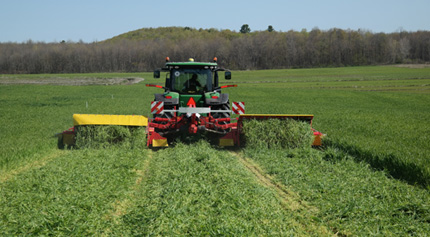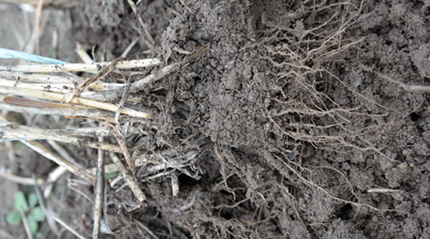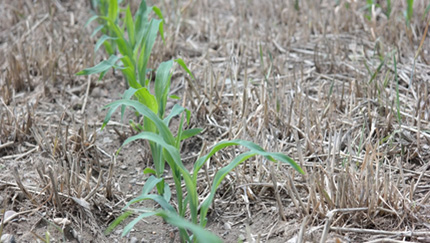5585 Guilford Road • Madison, WI 53711-5801 • 608-273-8080 • Fax 608-273-2021
www.agronomy.org
Twitter | Facebook
NEWS RELEASE
Contact: Hanna Jeske, Associate Director of Marketing and Brand Strategy, 608-268-3972, hjeske@sciencesocieties.org
Winter cover crop good for soil, cows, profit
Farming is risky business. There’s a need to maximize the quality and quantity of production, within the strict realities of time and environmental health. Finding the right combination of crops is part of the gamble, and one that’s important to keep farmers’ livelihood going.
 Triticale is a winter cover crop that limits the gamble with a trifecta of benefits. Triticale is a wheat-rye hybrid from the late 1800s. In New York State, 15 years of research finds triticale brings benefits to the field, the growers’ pockets, and dairy cows’ diets.
Triticale is a winter cover crop that limits the gamble with a trifecta of benefits. Triticale is a wheat-rye hybrid from the late 1800s. In New York State, 15 years of research finds triticale brings benefits to the field, the growers’ pockets, and dairy cows’ diets.
“It’s like a ball of string,” explains Tom Kilcer. “We’ve been unwinding the ball for a while and the more we unwind, the more we find good things happening.”
Kilcer is a private consultant with Advanced Ag Systems LLC and a Certified Crop Adviser. He and Cornell Cooperative Extension’s Quirine Kettering collaborated to tease out the growing details.
Triticale is mostly used as forage for cattle, but you might also see it in breakfast cereal ingredient lists. It has both the high yield of wheat and the cold tolerance of rye. It is this ability to overwinter—and do it well--that sets triticale apart.
In the fall, many fields contain nitrogen fertilizer left over from the summer’s crop growth. Manure or compost added during the warm months will continue to release nitrogen until slowed by the cold. Fields that are left empty lose that nitrogen back to the atmosphere - or worse, with the natural flow of water, through and off the field. The latter can contribute to poor water quality and algal blooms downstream. And since algae removes oxygen from the water, other aquatic life is unable to survive. Dead zones can be the tragic end. This is a huge loss for the environment and for the farmers that depend on it.
“Anytime we have nutrients leaving the field, it’s money running off the farm,” Kilcer says. “Nutrient runoff has to go someplace—is it the local town watershed, stream, the Great Lakes, Gulf of Mexico?”
 Instead, Kilcer suggests keeping the nitrogen local. “By planting a crop of winter triticale, we are able to capture and store that nitrogen,” he says. His goal is to plant the triticale so it can grow as much as possible between the harvest of the main summer crop and the arrival of forbidding winter cold. In fact, Kilcer has found that adding an extra kick of fertilizer in the fall brings more efficiency to the process, giving an extra growth spurt in triticale before the cold hits.
Instead, Kilcer suggests keeping the nitrogen local. “By planting a crop of winter triticale, we are able to capture and store that nitrogen,” he says. His goal is to plant the triticale so it can grow as much as possible between the harvest of the main summer crop and the arrival of forbidding winter cold. In fact, Kilcer has found that adding an extra kick of fertilizer in the fall brings more efficiency to the process, giving an extra growth spurt in triticale before the cold hits.
“What we have is a manure storage unit,” he says, pointing out the strong green triticale in a wintry field. The new triticale growth picks up the leftover nitrogen from the previous crop as well as the added fertilizer. His research suggests 50-60 pounds of nitrogen is kept out of waterways.
In his area, near Albany, NY, planting a cover crop of triticale before mid-September is key. Planting it in October doesn’t give enough growth time to the emerging triticale, and nutrients are lost.
The autumn growth of triticale has another benefit: soil health. Triticale’s roots are tenacious, holding the soil in place through difficult winter and spring months. Further, when left in the field, the roots and top growth decompose. This returns more organic matter and nutrients to the soil.
For growers, an added attraction with triticale is the economic return. “Most cover crops cost money to establish and stop in the spring, without an immediate return to the farmer. Triticale, while having all the great benefits of cover crops, also gives a direct return in spring to the farmer’s checkbook by producing forage,” Kilcer says. This can lessen the economic impact if severe weather, such as drought, affects the primary summer crop.
Adding to this return is triticale’s high quality as feed for cows—especially lactating cows who need easily digestible energy and fiber. “We are talking really good feed, nutritionally, that’s more digestible for cows,” Kilcer asserts. “It helps the cows keep producing milk even in summer’s heat.” That means more milk production, and economic security.
 One word of caution from Kilcer: allelopathy. This term refers to a plant’s ability to release natural chemicals that inhibit growth of another plant. Some might call it plant warfare. Not all plants can do this, but triticale can.
One word of caution from Kilcer: allelopathy. This term refers to a plant’s ability to release natural chemicals that inhibit growth of another plant. Some might call it plant warfare. Not all plants can do this, but triticale can.
Triticale releases its natural chemicals to the soil to eliminate competitor plants. The result is corn, sorghum, teff, and some cool season grasses, as well as some weeds, will not grow at all or grow poorly. Kilcer found growth of these crops can still be successful by planting between the triticale rows. Legumes, including soy and alfalfa, are not affected and can be directly planted into the harvested triticale stubble.
Kilcer continues to push the timeline on how early to plant the triticale. This past winter, however, two of his three research sites had uninvited dinner guests: deer cleared the fields. Another winter, deer-free, will need to pass to refine the research further.
Kilcer’s webinar about the soil, feed, and economic trifecta, “Winter Triticale - Maximizing Forage, Protect the Environment 365 Days a Year” can be viewed at www.agronomy.org/education/classroom/classes/285. It qualifies as a continuing education credit for Certified Crop Advisers.